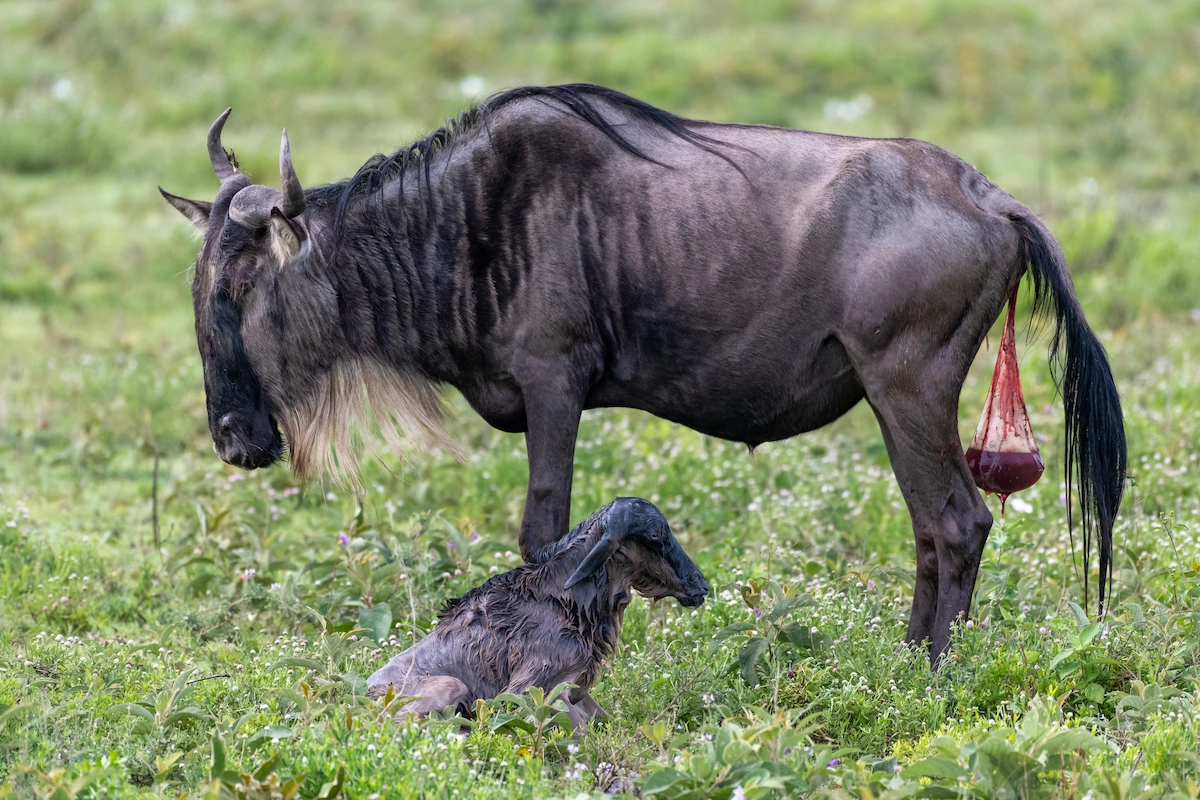
Experience a 5-day Ndutu Calving Safari in Serengeti & Ngorongoro. Witness newborn wildebeest, predators, and thrilling wildlife moments.
What to See – The Magic of the Calving Season
From January to March, the Ndutu plains become the birthing ground for the Great Migration, with over 500,000 wildebeest calves born within just a few weeks. This synchronized calving is an incredible sight, as newborns take their first steps within minutes of birth, instinctively following their mothers across the grasslands.
However, with new life comes danger. The large concentration of vulnerable calves attracts predators such as lions, cheetahs, leopards, and hyenas, leading to some of the most thrilling wildlife interactions. You may witness a mother fiercely defending her newborn, a cheetah sprinting across the plains in pursuit of a weak calf, or hyenas working together to take down prey. Jackals, vultures, and other scavengers complete the cycle, ensuring that no opportunity for survival is wasted. The Ndutu region allows off-road game drives, giving you a front-row seat to this dramatic spectacle. Unlike other parts of the Serengeti, this flexibility allows for close-up encounters with both the migrating herds and the predators that follow them.
A visit to the Ngorongoro Crater adds another layer of excitement to this safari. The crater’s unique ecosystem, a UNESCO World Heritage Site, is home to the Big Five (lion, leopard, elephant, buffalo, and rhino) and offers some of the best wildlife viewing opportunities in Africa. The crater lake attracts flamingos, hippos, and a variety of bird species, while the open grasslands are patrolled by large lion prides and roaming hyenas.
How to Dress on Safari:
Comfort and practicality are essential for an enjoyable safari experience. Opt for neutral-colored clothing (khaki, green, or brown) to blend in with the environment and minimize attention from insects. During the day, lightweight and breathable clothing will keep you cool, while a warm fleece or jacket is necessary for the cooler mornings and evenings. Sturdy hiking boots or comfortable closed shoes are recommended for game drives and any optional walking activities. Accessories like a wide-brim hat, sunglasses, and sunscreen will help protect you from the sun, while a light rain jacket is advisable if traveling during the green season.
What to Carry on Safari:
A good pair of binoculars enhances wildlife viewing, allowing you to spot distant animals or catch details of a predator’s movements. A camera with extra batteries and memory cards ensures you can capture the unforgettable moments of your safari. Staying hydrated is crucial, so carrying a reusable water bottle is highly recommended. Insect repellent helps protect against bites, and personal medications or a basic first aid kit should always be part of your essentials. A small backpack is useful for carrying daily necessities during game drives.
Best Time to Travel & Safari Seasons:
Tanzania offers fantastic safari experiences year-round, but each season brings different highlights.
The Dry Season (June - October) is considered the peak safari season. Wildlife viewing is at its best as animals gather around scarce water sources, and the skies are clear with minimal rain. If you’re interested in the Great Migration river crossings, this is the ideal time to visit the northern Serengeti (July - September).
The Green Season (November - May) offers lush landscapes, fewer crowds, and excellent opportunities for birdwatching as migratory species arrive. From January to March, the calving season takes place in the Southern Serengeti and Ndutu, attracting predators and providing a thrilling wildlife spectacle. This is one of the best times to witness predator-prey interactions and see the Great Migration at its most dramatic.
Conclusion
This 5-day Ndutu Calving Safari provides a front-row seat to one of nature’s greatest shows, blending breathtaking landscapes, incredible wildlife encounters, and the raw beauty of the Serengeti and Ngorongoro.